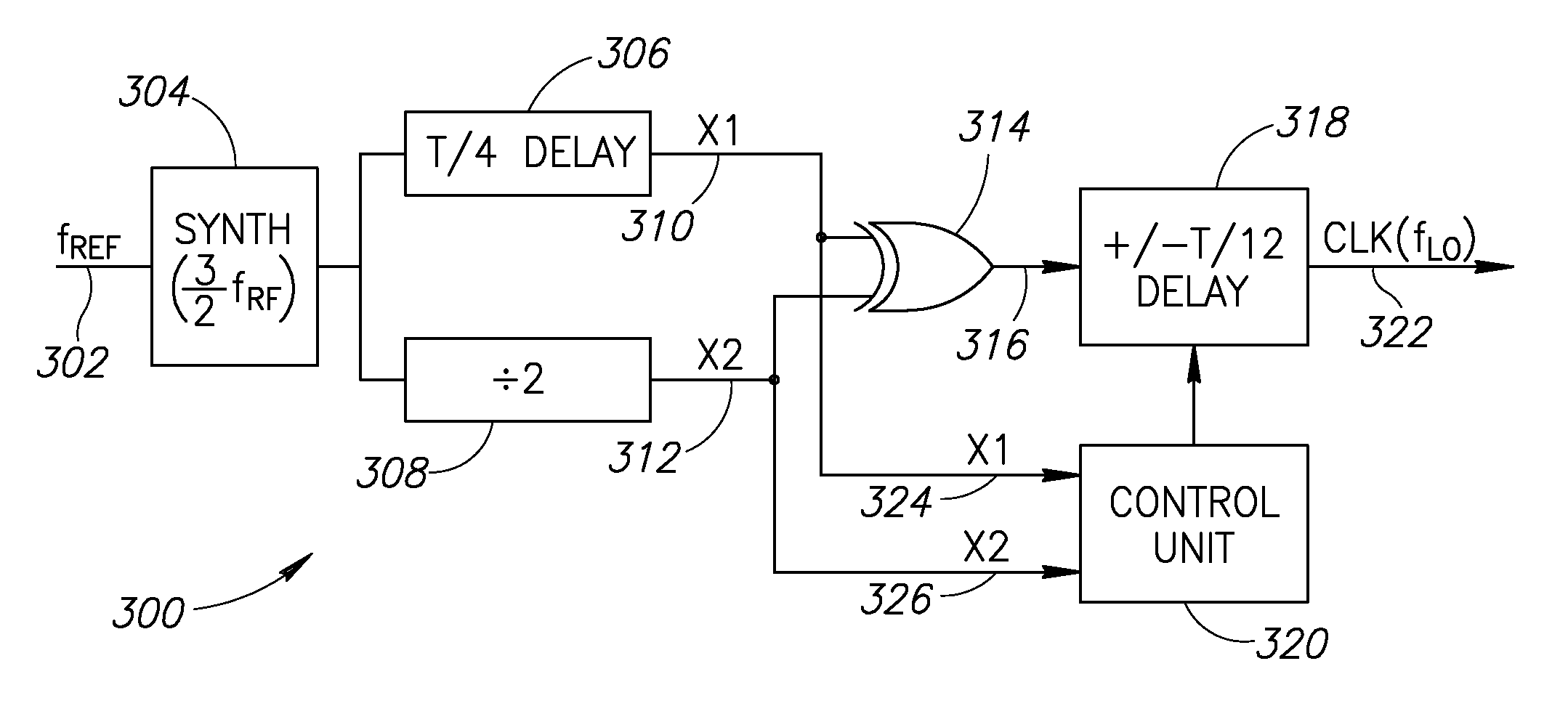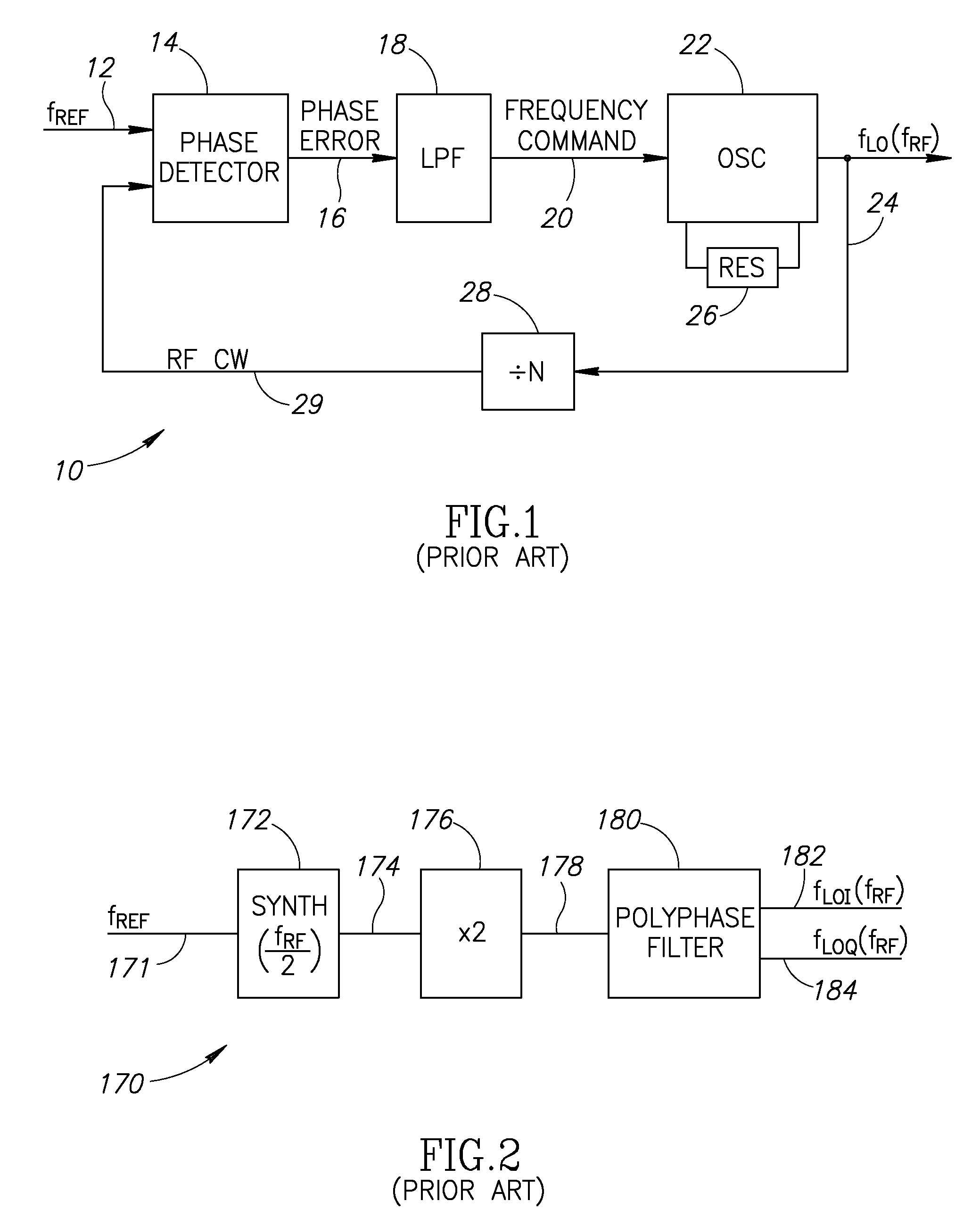Local oscillator with non-harmonic ratio between oscillator and RF frequencies using XOR operation with jitter estimation and correction
a local oscillator and non-harmonic ratio technology, applied in pulse generators, instruments, pulse techniques, etc., can solve the problems of complex converters that run at very high frequencies, unable to transmit a wideband signal in high frequency bands such as 5 ghz, and the susceptibility of rf signal interference, etc., to achieve a simple implementation of a drp based radio
- Summary
- Abstract
- Description
- Claims
- Application Information
AI Technical Summary
Benefits of technology
Problems solved by technology
Method used
Image
Examples
first embodiment
Non-Harmonic DCO With XOR and BPF (Offset LO Generator)
[0103]In a first LO generation scheme, the basic PLL structure runs at 4 / 3 the desired frequency fRF. This frequency is divided by two to obtain in-phase and quadrature square waves at ⅔fRF. It is noted that the division by two would not be necessary if the quadrature generation of the square wave clocks is achieved through some other means. In this case, the oscillator could operate at a lower frequency. The in-phase signal is divided by two again to obtain in-phase and quadrature square waves at ⅓fRF. The signals are then logically mixed using XOR operations to obtain I and Q branch signals containing spectral spurs every ((2n+1) / 3)fRF, where n is an integer. Since the spurs are located in non-disturbing bands, they can be filtered out. In a deep-submicron chip, for example, there is a need for a digital implementation of the above described LO generation scheme.
[0104]A block diagram illustrating a first embodiment of the loca...
second embodiment
Non-Harmonic DCO With XOR and Jitter Compensation #1
[0121]A block diagram illustrating a second embodiment of the local oscillator generation mechanism of the present invention is shown in FIG. 11. The circuit, generally referenced 300, comprises a synthesizer 304, T / 4 delay 306, frequency divider 308, XOR gate 314, ±T / 12 delay 318 and control unit 320.
[0122]In operation, a reference signal fREF 302 is input to a synthesizer tuned to exactly ⅔fRF. Alternatively, the 4 / 3fRF configuration with a quadrature divider generating 90-degree spaced clocks could be used. In this case, the T / 4 delay would not be needed. The digital output of the synthesizer is input to a T / 4 delay 306 and a divide by two circuit 308. The outputs of both blocks are XORed together via XOR circuit 314. The output of the XOR circuit is input to a programmable ±T / 12 delay 318. Since the absolute delay of block 318 does not change the overall structure, a “negative delay” can be achieved using two paths whose relat...
third embodiment
Non-Harmonic DCO With XOR and Jitter Compensation #2
[0126]A block diagram illustrating a third embodiment of the local oscillator generation mechanism of the present invention is shown in FIG. 13. The circuit, generally referenced 340, is a second implementation of the local oscillator generation scheme of FIG. 11. The circuit 340 comprises a synthesizer 344, T / 4 delay 348, frequency divider 350, −T / 12 delay circuit 353, T / 12 delay circuit 354, multiplexer 358 and control unit (CU) 360.
[0127]In operation, a reference signal 342 is input to a synthesizer 344 tuned to exactly ⅔fRF. The digital signal 346 output of the synthesizer is input to both a T / 4 delay circuit 348 as well as divide by two circuit 350, which are operative to generate signals X1362 and X2364, respectively. Note that here too, as described before, the T / 4 delay circuit 348 is not needed if a quadrature generation of the 346 signal is available. Signal X1 undergoes delays of −T / 12 via delay circuit 352 and +T / 12 vi...
PUM
 Login to View More
Login to View More Abstract
Description
Claims
Application Information
 Login to View More
Login to View More - R&D
- Intellectual Property
- Life Sciences
- Materials
- Tech Scout
- Unparalleled Data Quality
- Higher Quality Content
- 60% Fewer Hallucinations
Browse by: Latest US Patents, China's latest patents, Technical Efficacy Thesaurus, Application Domain, Technology Topic, Popular Technical Reports.
© 2025 PatSnap. All rights reserved.Legal|Privacy policy|Modern Slavery Act Transparency Statement|Sitemap|About US| Contact US: help@patsnap.com



